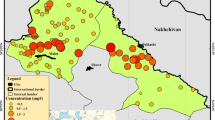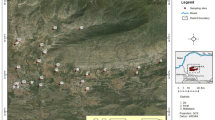Abstract
The fluoride level in drinking water is an important parameter and has to be controlled in order to prevent dental and skeletal fluorosis. The objective of this study is to assess fluoride content and other water quality parameters in the samples taken from open wells, tube wells, and karezes of Mastung, Mangochar, and Pringabad areas of Balochistan province. A total number of 96 drinking water samples out of 150 were found unfit for human consumption. Area-wise analysis show that the samples from 39 sites from Mastung, 12 from Mangochar, and 13 from Pringabad were found in the risk of dental fluorosis of mild to severe nature. However, 12 sampling sites from Mastung, 8 from Mangochar, and 2 from Pringabad were identified as the risks of mottling and skeletal fluorosis or other bone abnormalities. The highest concentration of F− has been observed as 14 mg L−1 in Mastung. Correlation analysis show that fluoride solubility in drinking water is pH dependent; and the salts of Ca2+, Na+, K+, Cl−, and SO4 2− contribute to attain the favorable pH for dissolution of fluoride compounds in drinking water. Principal component analysis shows that the geochemical composition of the rocks is only responsible for groundwater contamination. On the basis of the results, defloridation of the identified sampling sites and continuous monitoring of drinking water at regular basis is recommended at government level to avoid further fluorosis risks.




Similar content being viewed by others
References
Aijaz, M., Scheik, Z., & Azfar, S. F. (2011). Mastung District Government. Mastung - Integrated District Development Vision. IUCN Pakistan, Quetta, Pakistan. https://cmsdata.iucn.org/downloads/pk_mastung_iddv.pdf. Accessed 30 June 2015.
APHA, AWWA & WEF. (1992). Standard methods for examination of water and wastewater (18th ed.). Washington: American Public Health Association, Washington, DC.
De Zuane, J. (1997). Chemical parameters—inorganics. In Handbook of drinking water quality (2nd ed., p. 119). New York: John Wiley & Sons. doi:10.1002/9780470172971.ch3.
Dote, T., Kono, K., Usuda, K., Nishiura, H., Tagawa, T., Miyata, K., et al. (2000). Toxicokinetics of intravenous fluoride in rats with kidney damage caused by high-dose fluoride exposure. International Archives of Occupational and Environmental Health, 73(Suppl), 90–92.
EPA (United States Environmental Protection Agency) (2012). 2012 Edition of the drinking water standards and health advisories (p. 8). Office of water U.S. Environmental Protection Agency Washington, DC. http://water.epa.gov/action/advisories/drinking/upload/dwstandards2012.pdf. Accessed 25 Feb 2015.
Guan, Z. Z., Wang, Y. N., Xiao, K. Q., Dai, D. Y., Chen, Y. H., Liu, J. L., et al. (1998). Influence of chronic fluorosis on membrane lipids in rat brain. Neurotoxicology and Teratology, 20(5), 537–542.
Kumar, M., & Puri, A. (2012). A review of permissible limits of drinking water. Indian Journal of Occupational and Environmental Medicine, 16(1), 40–44.
Mineral profile of Balochistan (2009). http://www.gsp.gov.pk/images/mineralprofileofbalochistan.pdf. Accessed 22 Feb 2015.
Olayanju, G. M., Ayuk, M. A., & Adelusi, A. O. (2011). Geoelectrical mapping of the groundwater regime around the Federal Polytechnic Ado-Ekiti, South Western Nigeria. Journal of Geology and Mining Research, 3(8), 201–210.
Wang, A. G., Xia, T., Ru, R. A., Chen, X. M., & Yang, K. D. (2004). Antagonistic effect of selenium on oxidative stress, DNA damage, and apoptosis induced by fluoride in human hepatocytes. Fluoride, 37(37), 107–116.
WHO (World Health Organization) (1963). Guidelines of drinking water quality recommendations: 1, Geneva.
WHO (World Health Organization) (2003). Total dissolved solids in drinking water: Background document for development of WHO guidelines for drinking-water quality (p. 1). http://www.who.int/water_sanitation_health/dwq/chemicals/tds.pdf. Accessed 25 Jan 2015.
WHO (World Health Organization) (2004a). Fluoride in drinking-water: Background document for development of WHO guidelines for drinking-water quality. (p. 5). http://www.who.int/water_sanitation_health/dwq/chemicals/fluoride.pdf. Accessed 25 Jan 2015.
WHO (World Health Organization) (2004b). Sulfate in Drinking-water: Background document for development of WHO guidelines for drinking-water quality. (p. 1). http://www.who.int/water_sanitation_health/dwq/chemicals/sulfate.pdf. Accessed 25 Jan 2015.
WHO. (World Health Organization). (2006). Fluoride in drinking-water (p. 7, 32). London: IWA Publishing.
Conflict of interest
The authors declare that they have no competing interests.
Author information
Authors and Affiliations
Corresponding author
Rights and permissions
About this article
Cite this article
Chandio, T.A., Khan, M.N. & Sarwar, A. Fluoride estimation and its correlation with other physicochemical parameters in drinking water of some areas of Balochistan, Pakistan. Environ Monit Assess 187, 531 (2015). https://doi.org/10.1007/s10661-015-4753-6
Received:
Accepted:
Published:
DOI: https://doi.org/10.1007/s10661-015-4753-6




